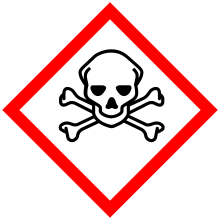
Back مادة خطرة Arabic বিপজ্জনক পণ্য Bengali/Bangla Mercaderia perillosa Catalan Gefahrgut German Material peligroso Spanish مواد خطرناک Persian Matière dangereuse French Ábhair ghuaiseacha Irish Mercadoría perigosa Galician חומרים מסוכנים HE


Dangerous goods (DG) are substances that are a risk to health, safety, property or the environment during transport. Certain dangerous goods that pose risks even when not being transported are known as hazardous materials (syllabically abbreviated as HAZMAT or hazmat). An example for dangerous goods is hazardous waste which is waste that has substantial or potential threats to public health or the environment.[1]
Hazardous materials are often subject to chemical regulations. Hazmat teams are personnel specially trained to handle dangerous goods, which include materials that are radioactive, flammable, explosive, corrosive, oxidizing, asphyxiating, biohazardous, toxic, poisonous, pathogenic, or allergenic. Also included are physical conditions such as compressed gases and liquids or hot materials, including all goods containing such materials or chemicals, or may have other characteristics that render them hazardous in specific circumstances.
Dangerous goods are often indicated by diamond-shaped signage on the item (see NFPA 704), its container, or the building where it is stored. The color of each diamond indicates its hazard, e.g., flammable is indicated with red, because fire and heat are generally of red color, and explosive is indicated with orange, because mixing red (flammable) with yellow (oxidizing agent) creates orange. A nonflammable and nontoxic gas is indicated with green, because all compressed air vessels were this color in France after World War II, and France was where the diamond system of hazmat identification originated.